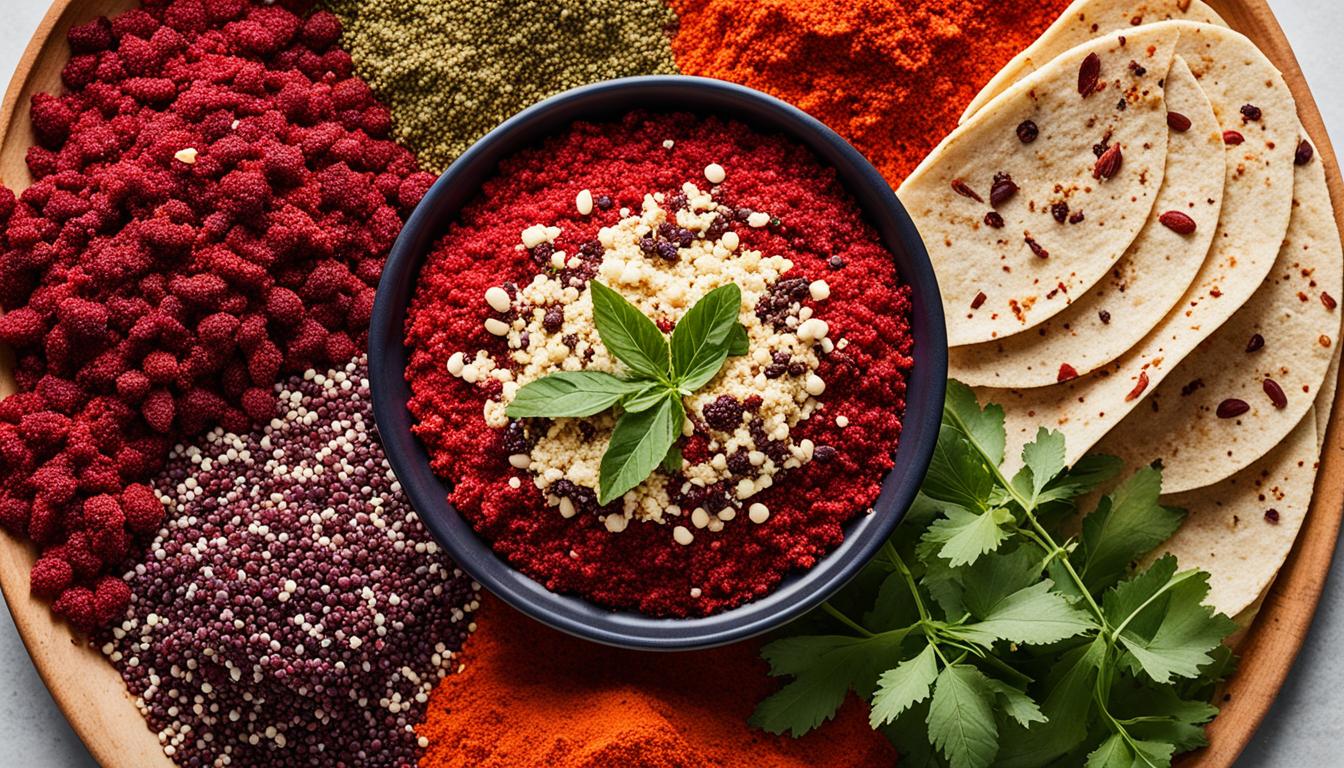Sumac is a key spice in Middle Eastern cooking. It’s tangy, smoky, earthy, and a bit sour. This spice adds a unique flavor and color to food.
I’ll share how sumac is used in cooking and its health perks. It’s great for both experts and beginners in Middle Eastern food. You’ll see why sumac is a must-have spice.
Sumac brings a unique taste to Middle Eastern dishes. It’s great for meats and salads. This spice can make your cooking better, from starters to desserts.
It’s also good for you because of its antioxidants. So, let’s learn more about sumac. This spice can make your dishes stand out.
What is Sumac?
Sumac is a spice that has caught the attention of food lovers around the world. It has a tangy flavor that adds something special to dishes. This spice comes from the dried berries of the Rhus coriaria shrub, found in the Mediterranean.
It’s interesting to know that sumac is related to the cashew family. It belongs to the anacardiaceae plant group.
Exploring the Origins and Varieties of the Tangy Spice
The Rhus coriaria shrub, also known as Sicilian or Tanner’s sumac, has a rich history. It was first grown in the Mediterranean, including Italy, Turkey, and the Middle East. Now, sumac is loved in many parts of Europe and beyond.
Sumac comes in different colors and flavors. Some have a deep purple color and a milder taste. Others are more vibrant and have a stronger flavor. But they all share a unique tang that makes them special in Middle Eastern cooking.
“Sumac’s distinctive tangy notes make it a unique and indispensable addition to many savory and sweet Middle Eastern recipes.”
The Captivating Flavor of Sumac
Sumac is a tangy spice you might not know about. It has a unique flavor that stands out. It tastes like a mix of tart, lemony notes and earthy, almost floral undertones.
Imagine the zing of fresh lemon juice with a subtle sweetness and complexity. That’s what sumac tastes like.
So, what does sumac taste like? It’s a dry, powdery spice that adds a “dry acid” quality to dishes. This makes it perfect for many Middle Eastern dishes.
It’s great for marinades, dry rubs, and sprinkled on top to enhance flavors.
“Sumac’s flavor is truly captivating – it’s like a symphony of citrus, spice, and earth, all coming together to create something truly unique and delightful.”
If you’re into Middle Eastern cuisine or want to spice up your cooking, the tangy spice you didn’t know you needed is a must. Sumac is versatile and adds a special touch to dishes.
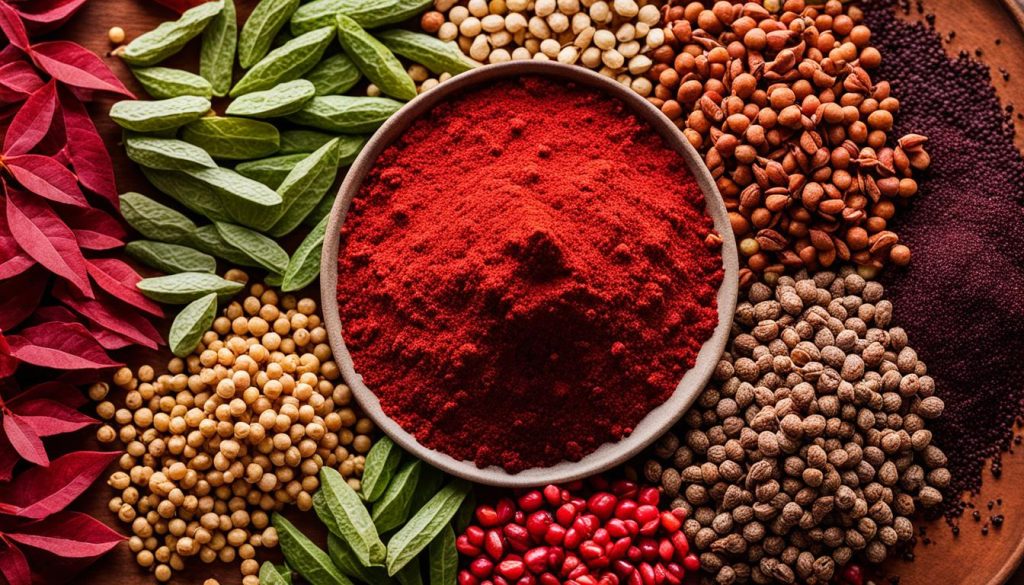
Exploring middle eastern dishes featuring sumac: a flavorful guide will show you how sumac can make simple dishes amazing. It’s great for marinades and rice dishes, adding a unique flavor.
Versatile Culinary Applications of Sumac
I love sumac, the tangy spice from Middle Eastern cuisine. It’s been a key ingredient for centuries. It makes many dishes taste better, from savory to sweet. I’m excited to share how I use it in my cooking.
Unleashing Sumac’s Potential
Sumac adds a bright, lemony taste to many foods. It’s great in marinades, dressings, and dips. I use it to spice up my grilled chicken or fish. It also makes my homemade hummus taste amazing.
But sumac isn’t just for savory dishes. It adds a special tartness to sweet foods like strawberry desserts. It also brings depth to savory pastries.
| Dish | How Sumac Can Be Used |
|---|---|
| Fattoush Salad | Sprinkled over the salad to add a bright, lemony flavor |
| Grilled Chicken or Fish | Rubbed onto the protein before grilling to create a flavorful crust |
| Homemade Hummus | Stirred into the dip to provide a subtle tanginess |
| Strawberry Shortcake | Dusted over the biscuits or whipped cream for a unique flavor twist |
Sumac is amazing in many dishes, from marinades to desserts. It’s a spice I didn’t know I needed. Now, I can’t cook without it. If you want to try Middle Eastern flavors or add something new to your recipes, sumac is a must.
Where to Buy High-Quality Sumac
Finding sumac can feel like a treasure hunt. But, I’ve found great places to share with you. Sumac is a tangy spice you might not know about. You can find it in Middle Eastern grocery stores, where it’s often of high quality.
Many big supermarkets also carry it, usually in the international or spice sections. It’s getting popular, so you might see it more often.
When buying sumac, choose high-quality, all-natural kinds. Make sure they only have sumac berries and no extra food coloring or citric acid. These pure spices will give your dishes a true Middle Eastern taste.
The key to unlocking sumac’s full potential is finding the freshest, most flavorful version of the spice.”
I love our online shop for all-natural sumac. We pick a few items to make sure they’re fresh and strong. This means you get the best sumac for your kitchen, with a great taste.
If you want to try new Middle Eastern dishes or add sumac to your pantry, look for high-quality, all-natural options. A bit of searching will help you find the sumac you need. This spice will make your cooking exciting.
Sumac: The Tangy Spice You Didn’t Know You Needed
If you haven’t tried sumac yet, it’s time to get to know it. This spice has a bright, lemony taste and a deep red color. Sumac can make many dishes better, from savory marinades to sweet desserts. It’s perfect for adding color and tang to Middle Eastern-inspired meals or for trying something new in your cooking.
Sumac changes how a dish tastes. Its tangy flavor can make heavy or rich foods taste fresh and interesting. You can use it on roasted veggies or in marinades for grilled meats. Sumac is very versatile.
Sumac is not just for taste; it’s also good for you. It’s full of antioxidants and can help with digestion, reduce inflammation, and support weight management. Adding sumac to your meals is a tasty way to get healthier.
If you want to try new spices and make your Middle Eastern dishes better, consider sumac. It’s a spice you might not have thought about before, but once you try it, you’ll love it.
Substitutes for Sumac in a Pinch
Sumac is a key spice in Middle Eastern cooking. But, you might not always have it at home. Don’t worry, there are other spices you can use as a substitute. These can help you get close to the taste of sumac when you’re out.
Alternatives to Recreate the Tangy Essence
- Lemon zest: Lemon zest has a bright, citrusy taste like sumac. But, use it carefully because it’s more sour.
- Lemon juice: Fresh lemon juice adds a tartness similar to sumac. Yet, it doesn’t have sumac’s deep flavor.
- Lemon crystals: These are a concentrated lemon seasoning. But, check the ingredients for extra stuff you might not want.
- Lemon pepper: This mix of lemon and pepper tastes tangy and peppery. It’s close to sumac’s flavor.
- Za’atar: This spice mix from the Middle East has sumac in it. So, it’s a good choice if you’re out of sumac.
These substitutes can give you a taste like sumac, but they’re not the same. They might not taste as good as the real thing. So, use them carefully and adjust the amount you use to your liking.
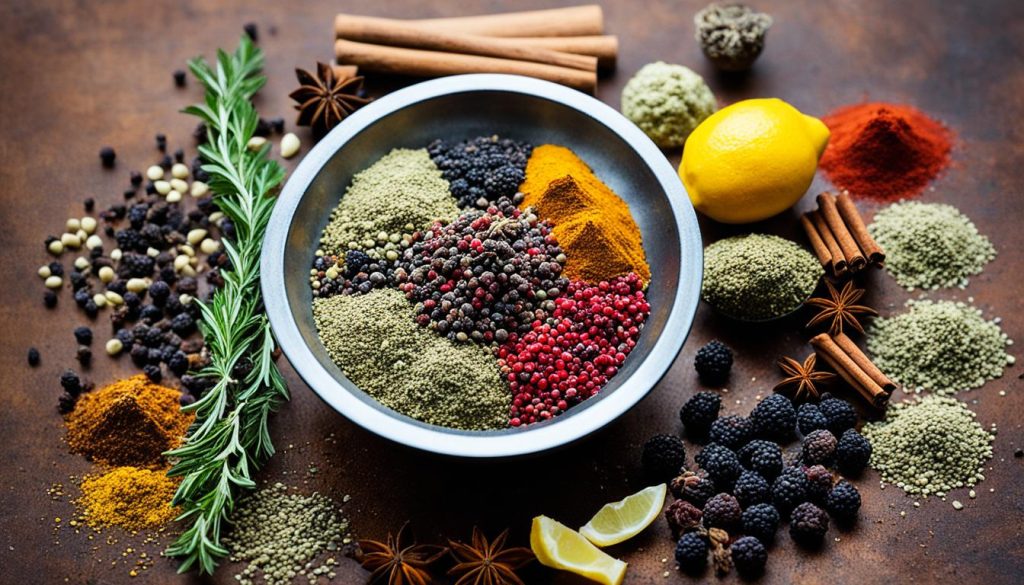
“When life gives you lemons, make lemonade. But when life takes away your sumac, get creative with these sumac substitutes!”
Avoiding Poison Sumac: Identifying the Edible Variety
I love cooking and exploring the tangy spice sumac. It’s key to know the difference between edible and poisonous sumac. They both belong to the Anacardiaceae family but are quite different.
Poison sumac grows in wet places in the eastern U.S. It has a toxin called urushiol. This toxin causes a bad rash, so it’s important to avoid it. Poison sumac has white berries, unlike the deep red berries of the safe sumac.
When looking at what is poison sumac, check the plant closely before using it. The safe sumac is what you want for cooking. With some knowledge, you can easily tell them apart. This way, you can enjoy the the tangy spice you didn’t know you needed in your cooking.
“Sumac is a versatile and essential ingredient in many Middle Eastern dishes, but it’s crucial to understand the difference between the edible and poisonous varieties. Knowing what to look for can make all the difference in your culinary adventures.”
Proper Storage for Maximum Freshness and Longevity
Keeping sumac fresh and full of flavor is easy with the right storage. Whether you have ground or whole sumac, store it in a dark, cool place. This means an unheated pantry or spice rack is perfect.
Tips to Preserve Sumac’s Vibrant Flavors
Ground sumac can stay fresh for months if stored right. Whole dried berries can last over a year. Follow these tips to keep sumac fresh for your cooking.
- Store sumac in an airtight container, such as a glass jar or resealable bag.
- Keep the container in a cool, dark place, away from direct sunlight and heat sources.
- Avoid storing sumac in the refrigerator or freezer, as fluctuating temperatures can degrade its flavor.
- Check the container periodically for any signs of moisture or clumping, which can indicate the sumac is losing its freshness.
- For ground sumac, try to use it within 6 months for maximum flavor, while whole dried berries can last over a year when stored properly.
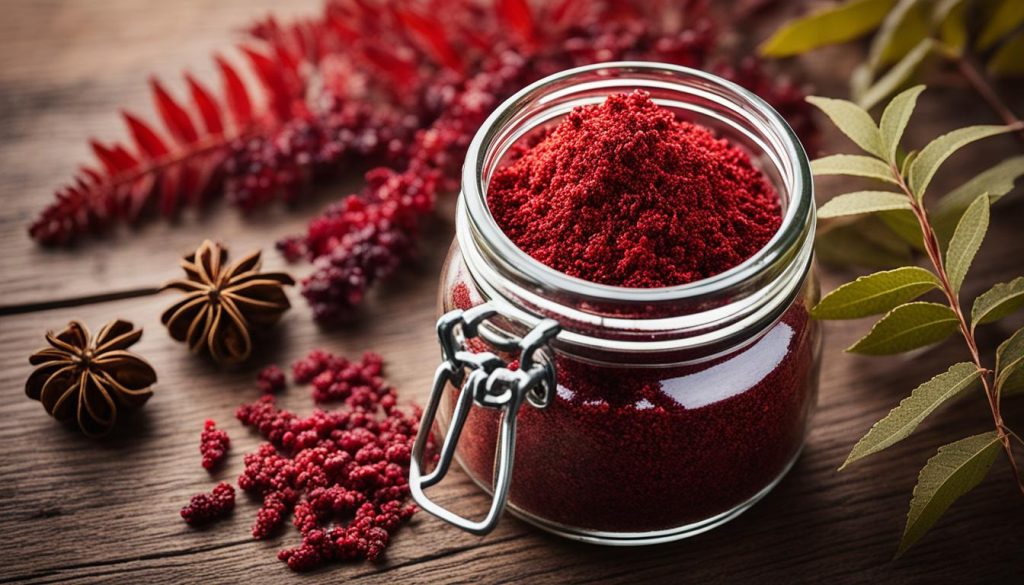
Follow these tips to enjoy sumac’s tangy, earthy taste in your dishes. It makes Middle Eastern meals special.
Middle Eastern Dishes Featuring Sumac: A Flavorful Guide
Sumac is a key spice in many Middle Eastern dishes. It adds a tangy, citrusy flavor. This spice can make both savory and sweet dishes taste better.
The fattoush salad is a classic dish with sumac. It has crisp greens, toasted pita bread, and fresh veggies. Sumac makes the dressing tangy.
For a main course, try musakhan. It’s a Palestinian dish with roasted chicken, onions, and spices. Sumac gives it a vibrant flavor.
Sumac isn’t just for savory dishes. It can also be used in desserts. Imagine sumac in shortbread or meringue, adding a citrusy twist. Sumac is also good for you, with antioxidants and anti-inflammatory effects.
Sumac is great for making hummus, marinating chicken, or baking. It’s a must-have spice for exploring Middle Eastern flavors. Let sumac take your taste buds on a delicious journey.
| Middle Eastern Dish | Role of Sumac |
|---|---|
| Fattoush Salad | Key ingredient in the tangy dressing |
| Musakhan (Roasted Chicken) | Adds a vibrant, aromatic flavor to the dish |
| Hummus | Can be used to add a subtle tangy note |
| Sumac-Infused Baked Goods | Provides a unique citrusy twist to desserts |
Sumac is a versatile spice that can transform the flavors of both savory and sweet dishes in Middle Eastern cuisine.
Sumac: A Multifaceted Spice for Savory and Sweet Dishes
Sumac is more than just a spice in Middle Eastern food. It adds a tangy, lemony flavor to many dishes. It can make a simple salad brighter, add depth to grilled meats, or give baked goods an unexpected twist. Every home cook should have sumac in their kitchen.
Unleashing Sumac’s Potential in Diverse Cuisines
Sumac can make many dishes better, from Middle Eastern dishes to new recipes. Sprinkle it on roasted veggies, mix it into meat marinades, or add it to salad dressings. For something sweet, try it in baked goods or with fruit desserts.
| Savory Dishes | Sweet Dishes |
|---|---|
|
|
Exploring the health benefits of sumac spice opens up new cooking possibilities. It adds a tangy, lemony flavor to dishes. Whether you love Middle Eastern food or want to try new spices, sumac can take your cooking to the next level.
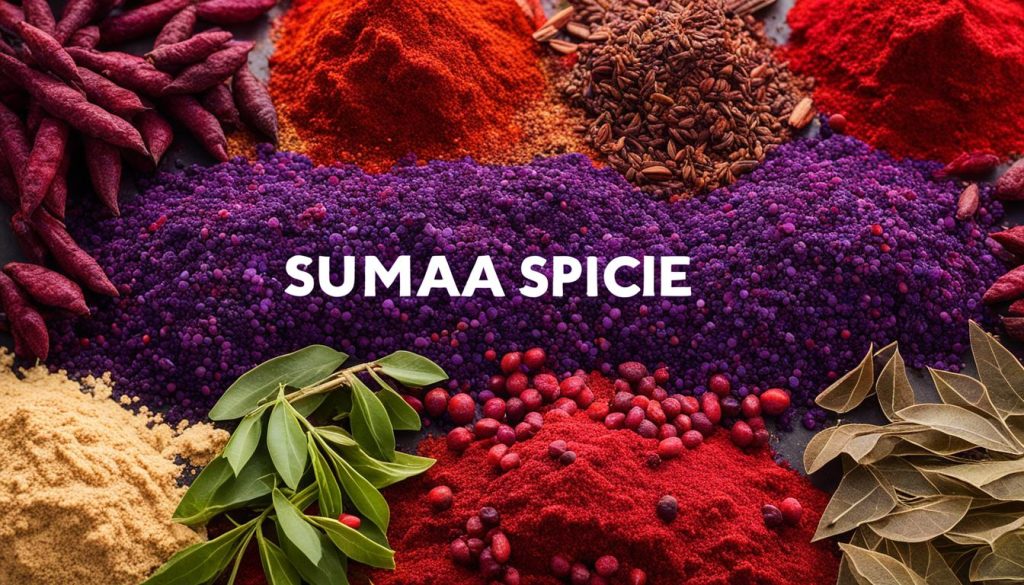
“Sumac is a game-changer in the kitchen, adding a unique and delightful flavor that can transform both savory and sweet dishes.”
Health Benefits of Sumac Spice
Sumac is a tangy spice you might not know about. It’s more than just a flavor booster. It comes from the Middle East and is packed with antioxidants. These can help your immune system and lower inflammation.
Some studies say sumac might fight bacteria and help with diabetes. But we need more research to be sure. Still, adding sumac to your food can be a good choice for your health.
Sumac is great in many dishes, from Middle Eastern to sweet treats. It’s a key spice for anyone who cares about their health. Using sumac lets you make tasty food that’s also good for you.

